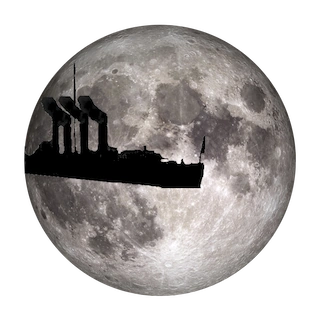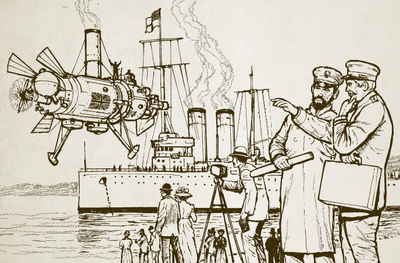This page--with several redirects to it--defines the concept of electroid-powered flyers and their broad history. You may be looking for Leviathans, HML Leviathan, Ganymède or Berkut.
The word leviathan in the parlance of the turn of the twentieth century was used to describe lighter than air vessels that achieve lift through the use of electroid. The best-known role of leviathans was that of aerial warship. However, "fast freighters" and military auxiliaries also plied the skies.[1][2]
Origin of the term[]
While it is commonly believed that the name "Leviathan" is a direct reference to the monster from the Book of Job, the intended reference was slightly different: when Lord Kelvin saw the first HML Leviathan armed and flying above the water, he said to Jackie Fisher, "With a fleet of these, England truly will become Hobbes’ Leviathan!", and so it was christened.[3]
Lord Kelvin referred to the book Leviathan by Thomas Hobbes, and specifically the frontispiece, shown here:

Leviathans would, indeed, become the new symbol of British power in the world, though hardly an exclusive one. Still, "leviathans" or "levs" remains the most common generic term for these craft. Other names include ganymèdes or ganys after the French Ganymède, berkuts (falcons) after the Berkut ship and class,[4] while the Japanese infantry at Port Arthur dubbed them Rairyuuha, or "Thunder Dragons".[5][6] Around the start of the Great War, the United States of America began styling their warships "USG", as in USG Virginia, after the French ganys of their allies, rather than the term leviathan of the British Empire.[7]
History[]
The first public appearance of these craft was at the Greater Britain Exhibition in 1890, where the Ganymède was closely followed by the HML Leviathan.[8] The years following saw rapid evolution of the technology:
First Generation Leviathans[]
The first generation of leviathans that appeared between 1891 and 1894 were limited in size, no larger than a "light cruiser" of 1910. The armor was thick enough to protect against most rifle fire, but little more, and the weapons were of short range. They mainly saw combat in French and British colonial ventures against opponents without the technological resources to match them. A few "battleships" in name only were flown, more for prestige.[9]
Second Generation Leviathans[]
In 1895, the introduction of the ducted airscrew marked the second generation of leviathan development. The discovery of this technology made leviathans faster, able to carry more tonnage, and better able to survive combat.[10] Some leviathans of this generation, such as OML Kaiserin Elisabeth, remained in service at the start of the Great War, though they were outmatched by more modern designs.[1]
Third Generation Leviathans[]
Second-generation leviathans soon became obsolete: between 1897 and 1906, multiple advancements created the third generation of leviathans: the two-stage ducted airscrew, a two-stage Tesla coil, and the Swann stabiliser. Armament remains similar to the previous generation, but speed, armor, and lift capacity all improve. Battlecruisers and battleships began to appear in the skies.[11][12]
Fourth Generation Leviathans[]
In 1906, the HML Leviathan, fourth of that name, heralded the fourth generation of leviathan development, being larger than previous battleships and capable of carrying turreted 12-inch guns.[13]
During this time period, some craft were built with or converted to petroleum fuel rather than coal.[4]
Principles of Operation[]
Lift--far more than can be generated with hydrogen--was generated by applying high-voltage electrical current to electroid.[8] This was typically kept in electroid tanks along the keel, as well as trim tanks along the outside of the vessel.[11] From 1891 on, the electrical current was typically provided by one of the generations of Tesla coil.[14]
Power, both electrical and motive, was provided by steam engines fueled by coal and, later, oil, that turned the airscrews (and later ducted airscrews) and also powered the electrical generators.[4]
Altitude was limited by both technological factor--electroid having a limit to how much it may be agitated before it "flashes over" into energy--and human factors--altitude sicknes being a very real danger for airmen.[15]
Bibliography[]
References[]
- ↑ 1.0 1.1 Last Flight of the Swan of the East
- ↑ A Test of Resolve
- ↑ Leviathans Gazetteer, p. 25
- ↑ 4.0 4.1 4.2 Leviathans Gazetteer, p. 13
- ↑ A Monster in the Sky
- ↑ Leviathans Gazetteer, pp. 44, 46, & 47
- ↑ https://www.kickstarter.com/projects/cgl/leviathans-the-great-war/posts/3689963
- ↑ 8.0 8.1 Leviathans Gazetteer, p. 6
- ↑ Leviathans Gazetteer, pp. 11-13
- ↑ Leviathans Gazetteer, p. 14
- ↑ 11.0 11.1 Leviathans Gazetteer, p. 9
- ↑ Leviathans Gazetteer, pp. 16-17
- ↑ Leviathans Gazetteer, p. 20
- ↑ Leviathans Gazetteer, p. 10
- ↑ Leviathans Gazetteer, p. 7

